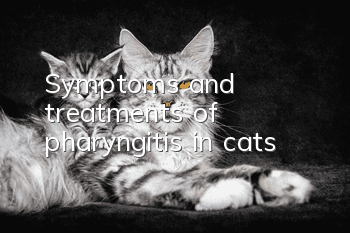Symptoms and treatments of pharyngitis in cats

There are many causes of pharyngitis in cats, so when treating pharyngitis in cats, you must pay attention to investigating the causes and prescribing the right medicine to completely cure the pharyngitis in cats. So how can you confirm that your cat has pharyngitis?
Cat pharyngitis is an inflammation of the pharyngeal mucosa and submucosa. Clinically, it is characterized by dysphagia, pharyngeal swelling, and pressure sensitivity. Inflammation and abscess often occur in the dorsum of the pharynx and submandibular lymph nodes. The most common causes are damage to the mucous membrane caused by bone fragments, iron wires, or unskilled drug administration techniques; or inhalation or ingestion of irritating or corrosive chemicals; catching a cold; or secondary systemic infectious diseases; or Stomatitis, rhinitis, laryngitis, etc. spread to the pharynx and cause inflammation.
Symptoms of cat pharyngitis
The course of primary cat pharyngitis usually heals well. If it turns into chronic inflammation and mucosal hyperplasia, it will be more difficult to cure. The treatment of cat pharyngitis also requires investigating the cause and then prescribing the right medicine.
So what are the symptoms of cat pharyngitis?
The initial symptoms are slow, difficult, or loss of appetite. You can refuse to drink water when swelling is obvious. Palpation of the pharynx shows increased sensitivity. Subbelinal lymph nodes, pharyngeal lymph nodes, and tonsils are swollen. If accompanied by laryngitis, it can cause coughing, difficulty breathing, and salivation. Cat resists oral examination due to pain. Acute pharyngitis is often accompanied by systemic symptoms, such as lack of energy, elevated body temperature, and dehydration. Treatment of cat pharyngitis
The course of primary pharyngitis usually has a good prognosis, but if it turns into chronic inflammation and mucosal hyperplasia, it will be difficult to cure.
1. If pharyngitis is caused by foreign body stimulation, the foreign body should be removed first (under anesthesia).
2. Use antibiotic therapy in a timely manner. Penicillin 50,000 units/kg body weight, intramuscular injection, 2 times/day. Pharyngeal sealing therapy can also be used. Penicillin 50,000 units/kg body weight, dexamethasone 0.5 mg/kg body weight, and 2% procaine 2 mg/kg body weight are mixed on both sides of the pharynx for sealing injection, 2 times/ day, for 3 consecutive days. Gentamicin 10,000 units/kg body weight, intramuscular injection, 2 times/day.
3. In the early stage of pharyngitis, ice packs can be used for cold compresses. When the heat pain is not obvious in the later stage, hot compresses can be used, such as infrared irradiation for 30 minutes each time or TDP irradiation for 30 minutes.
4. Cats that cannot eat should be given infusion therapy.
5. Give soft and easily digestible feed or liquid food.
- A cat will die if it urinates for a few days
- Should you deworm yourself or go to a pet store?
- Are cat teasers harmful to cats?
- What should I do if my cat suffers from chronic gingivitis?
- Cat's nails are cracked with a thin layer
- Cats go crazy after eating mutton
- What does cat moss on a cat’s chin look like?
- Can cats reproduce after abdominal transmission is cured?
- What exactly is the sterilization shot for female cats?
- Can I still eat unopened cat food if it has expired?



